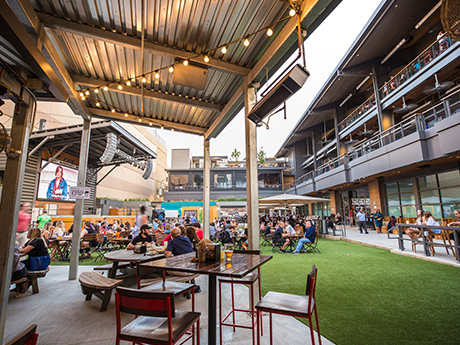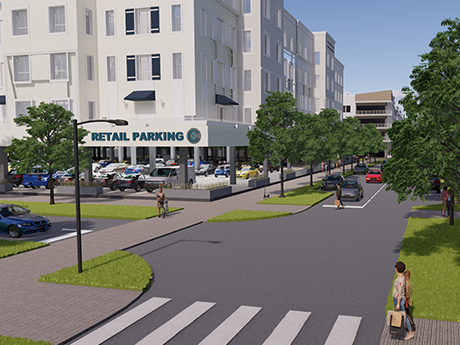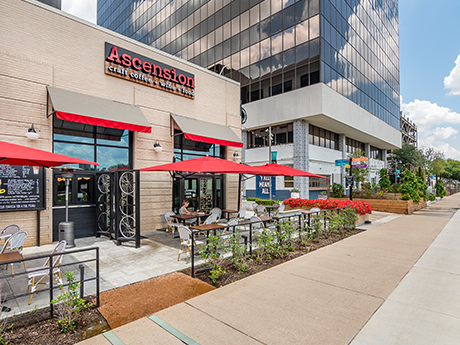By Taylor Williams
The factors that have long enticed Texas retailers and restaurants to locate in mixed-use environments are back in full force, such that these users are once again willing to pay a premium for spaces built-in density and walkability.
In some ways, this trend never really disappeared in Texas, one of the first states to reopen during the early months of COVID-19. Through measures passed in 2020 like sanctioning to-go alcohol sales and allowing businesses to stay open, albeit at reduced capacities, Texas has worked to minimize retail and restaurant closures and prevent large volumes of these spaces from being returned to markets.
Neither has the state’s job and population growth slowed during the 22-month global health crisis, allowing developers across all asset classes to push forward. In addition, the newfound desire from consumers and businesses to work, shop and dine outdoors as much as possible has kept trains rolling on mixed-use projects, which inherently connect different uses through external features like trails, open streets, pocket parks and plazas.
From a design standpoint, those connective features remain critically important, says Barry Hand, principal in the Dallas office of global architecture firm Gensler.
“Pocket or linear parks are viewed positively by stakeholders and developers as a way to spread the open space horizontally,” he says. “They can also work as arteries that link pedestrians back to the commercial cores. Small event lawns and water features surrounded by outdoor dining are urban attractors that are effective at containing energy, event programming and holding consumers longer.”
Collectively, these factors have laid the groundwork for demand for brick-and-mortar retail and restaurant spaces in mixed-use developments to flourish. But if the last two years have proven anything, it’s that market conditions can change in a flash.
“The recovery in late 2020 and throughout 2021 has far surpassed industry expectations,” says Terry Montesi, CEO of Fort Worth-based Trademark Property Co. “Retailers are expanding and sales are strong — we just don’t know yet how sustainable it is. Some of the strong leasing activity is due to pent-up demand, and some could be overreaction from retailers and restaurants needing to make up ground from 2020.”
Montesi does believe that certain pandemic-related trends within the space are here to stay. These include consumers’ desire for incorporating the outdoors into the shopping, dining and entertainment ventures as much as possible, as well as further solidification of the symbiotic relationship between e-commerce and physical stores. The former trend especially bodes well for mixed-use settings.
“More public spaces and outdoor seating for food and beverage (F&B) will be the norm,” he says. “People want to be in walkable environments, and most walkable developments have multiple uses. At the same time, it’s becoming obvious which retail properties are emerging as winners and survivors, and those are the ones that are anchored by true omnichannel retailers in locations that facilitate omnichannel distribution.”
To that end, Trademark, the developer of mixed-use projects like Victory Park in Uptown Dallas and Market Street in The Woodlands, is adjusting its brick-and-mortar philosophy a bit. Banking on the ideas that pent-up demand will fizzle out and that less ground-up, pure-play retail development will be needed in the future, Trademark is getting into the multifamily development game.
Tenant Mix Evolves
Yet other developers still view retail, restaurant and entertainment uses as the connective tissues that link other components of mixed-use projects, including office, multifamily and hotels. Mixed-use developments cater to people who are exclusively residents, office workers or hotel guests, but it’s within the shopping, dining and socializing arenas that these three groups are most likely to come together and interact.
“Retail is still the means by which we add character and uniqueness to a project,” says Lacee Jacobs, vice president of leasing and advisory services at Houston-based Midway. “It plays a big part in the type of office and multifamily tenants we can attract, in terms of price point and lifestyle.”
Midway’s latest major mixed-use project is East River, a 150-acre development in Houston’s Historic Fifth Ward, and the company recently announced new tenants for Phase I of East River. Broham Fine Soul Food & Groceries, a concept by James Beard Award-winning chef Jonny Rodes, has leased 4,000 square feet; the owners of The Astorian will debut a new 20,000-square-foot private event space and rooftop bar; Austin-based Lick Honest Ice Creams has committed to 1,124 square feet; and URBN Dental has inked a deal for 2,612 square feet.
“There are a few different categories of retail in mixed-use that you really need to have to be successful,” says Jacobs. “There’s the obvious daily-use retail, including class-based fitness or medical services, which isn’t as glamorous but is important because multifamily residents and office tenants expect those kinds of tenants.”
“Within the F&B space, there are a couple boxes you want to hit, including the quick-service and fast-casual lunch, the bar- and nightlife-oriented concepts and the impulse purchases like coffee or ice cream,” she continues. “All of those categories have to be represented and come together, because if you’re going to have residents and office workers onsite, they need all of those things.”

Situated within Legacy West in Plano, Legacy Hall is a 55,000-square-foot food hall with over 24 food kiosks and bars. The venue also houses a fully operational brewery, dining spaces and outdoor terraces facing the Box Garden, a live music and entertainment area that doubles as a beer garden. Developers say these features will continue to be hallmarks of food and beverage components of mixed-use projects.
Jacobs also says that when it comes to attracting visitors who have no ties to the residential, office or hospitality components of the property, the full-service restaurant and entertainment segments of the retail market are the key drivers.
“The key to F&B success in a mixed-use project lies in the ability to draw certain groups: lunch traffic, dinner traffic and weekend dinner and brunch consumers,” concurs David Littwitz, head of Houston-based restaurant brokerage firm Littwitz Restaurant Real Estate. “You want to try to lease F&B spaces to tenants that are not multiple-location concepts in your marketplace, essentially giving customers a reason to come to your mixed-use project because you have F&B concepts no one else has.”
Littwitz also says that in terms of rent for these spaces, tenants’ negotiating power is limited, especially when landlords know they have an ideal space and location for the concept.
“Our big problem today is that [rents for] triple-net leases in mixed-use projects tend to be higher than alternative locations, and you really can’t negotiate changes to triple-net rates,” Littwitz explains.
“But if a landlord wants an F&B concept badly enough because it would give them the only location for that concept, the idea of a tenant paying a premium rent sometimes disappears quickly,” he continues. “On the other hand, if the landlord knows that they have the right location for a certain F&B tenant — and the tenant knows it too — then a rent premium is in play as part of an overall occupancy cost discussion.”
The use of full-service restaurants lies at the center of the retail-within-mixed-use strategy of Centurion American Development Group. The Dallas-based firm is perhaps best known for its ongoing effort to redevelop Collin Creek Mall, a regional mall in Plano, into a mixed-use destination with a heavy residential component.
Centurion American owns several full-service restaurant brands that can be found in its communities throughout the metroplex. These include Primo’s, a Tex-Mex concept with a 30-year operating history, and Sfereco, a classic Italian restaurant that serves lunch and dinner. The company also recently launched a steakhouse concept.
“At our properties, aside from our restaurants, we’re predominantly focused on city-service tenants like hair and nail salons,” explains company vice president Sean Terry. “While these tenants don’t generate substantial income, they engender loyalty and engagement with our guests. They bring people out to our communities who are then much more likely to stay and eat at our restaurants.”
At Bright Realty’s flagship mixed-use development, the 324-acre Realm at Castle Hills in the northern Dallas suburb of Lewisville, the retail tenant mix is designed to promote convenience for the multifamily residents and office users.
“The types of retailers and restaurants we target haven’t changed much due to COVID,” says Lucas Patterson, executive vice president at Bright Realty. “We try to position our merchandise to reflect a certain type of lifestyle, which also overlaps with the kind of tenant we want in our multifamily and office buildings. For soft goods, that means athleisure, outdoor goods and sporting goods, alongside service tenants like hair salons and dry cleaners.”
To that end, Salon Bellus, a hair salon for women, has committed to a 1,804-square-foot store at The Realm at Castle Hills, as has Coolheads Salon for Men. The latter’s footprint is 1,350 square feet. Both users hope to open their stores during the first quarter.
In terms of restaurants, the goal is to provide F&B offerings at a price point that multifamily and office users can afford on a daily or weekly basis, as opposed to just a few times per year, Patterson says. The London Baker opened a 1,983-square-foot store in August, while two other F&B users — Salubrious Juice & More and Mochinut Donuts — have respectively signed deals for 1,390 and 1,033 square feet, respectively.
Lastly, Tex-Mex restaurant El Patio opened a 1,237-square-foot rooftop patio this summer where guests can enjoy food and drinks, as well as live music. Worth the Pour, a liquor store that provides wine tastings and delivers throughout the property, opened in September 2021. Both of these concepts and openings reflect Bright Realty’s effort to elevate convenience and daily usability of its F&B offerings for its office workers and multifamily residents.
New Modes of Transit
Terry says that at some Centurion American properties, particularly those on the outer suburban rings of the metroplex, restaurants now offer charging stations for golf carts — the primary way in which residents travel about the property.
While it’s not quite the same as walking, the use of such a vehicle undoubtedly captures the spirit of walkability and pedestrian friendliness that is pivotal to so many mixed-use communities.
“We’re now designing our streets to have that flexibility of travel that golf carts allow,” Terry says. “It’s part of creating the sense that these communities are like one big family.”
“Flexibility remains a key characteristic in successful mixed-use environments,” concurs Hand of Gensler. “Curbless streets that can be blocked off for pedestrian festival settings allow for streets to be utilized for specific or seasonal events. It’s also important to have zoning that allows for on-street parking that can flex from head-in parking to parallel parking to valet or pickup zones or pop-up outdoor dining/retail zones over time.”
While walking, biking and riding on golf carts all are part of the easygoing, connected experience that mixed-use destinations strive to craft, those modes of transit do not negate the need for dedicated, makeshift and overflow parking spaces. This holds particularly true for mixed-use properties that are heavy on full-service restaurant and entertainment uses, as these tenants tend to attract more visitors from outside the development.

Even as more mixed-use projects trend toward greater walkability, being able to convert green space to overflow parking space for visitors that frequent a development’s retail and restaurant uses remains critical. This is part of Centurion American’s strategy with its redevelopment of Collin Creek Mall (pictured above).
“It’s always a fine line between how we monitor surface parking that’s readily accessible for retailers and restaurants,” says Patterson. “We don’t want to overly enforce parking, but rather make it easy for people to go back and forth between various uses.”
Like most other mixed-use developers and operators, Bright Realty is also working to figure out the most economical ways to create patio space and dedicated parking for curbside pickup and third-party delivery operations for these tenants.
Patterson says that understanding parking requirements for each specific use gets easier as lease-up progresses and traffic patterns become more clear. Use of valet services, creation of short-term parking spaces and the ability to seamlessly convert common space to overflow parking are all key solutions to managing this critical development consideration.
Centurion American is building 2,400 underground parking spaces as part of its redevelopment of Collin Creek Mall. These spaces will not only serve the 15,000 or so residents who the company expects to ultimately live onsite, but also the retail component, which is going to be heavily rooted in experiential concepts and users.
Terry says it’s still too early to announce tenants at Collin Creek Mall, but calls are being made and received, and tenant profiles are starting to take shape. Grocery, boutique fitness and experiential electronics showrooms are among the main categories represented in this mix.
— This article originally appeared in the January 2022 issue of Texas Real Estate Business magazine.


